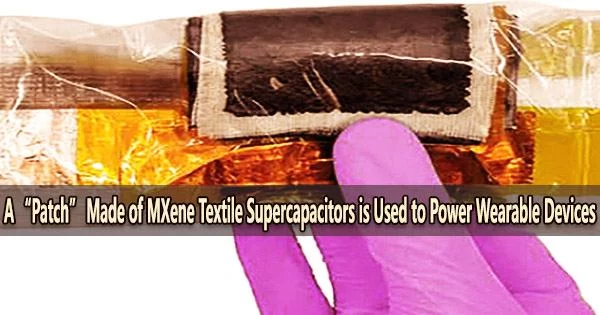Wearable technology is powered by a variety of energy sources, including batteries, rechargeable batteries, and kinetic energy generators. The most common type of power source for wearable technology is a rechargeable battery. Some wearable devices, such as fitness trackers, are designed to last for several days on a single charge, while others, such as smart-watches, may need to be charged every night.
Wearable textile technology is getting closer to reality thanks to research from Drexel University. Recently published in the Journal of Materials Chemistry A, materials scientists from Drexel’s College of Engineering, in partnership with a team at Accenture Labs, have reported a new design of a flexible wearable supercapacitor patch.
An Arduino microcontroller temperature sensor and radio data transmission are powered for approximately two hours by a textile-based supercapacitor that employs MXene, a substance developed at Drexel University in 2011.
“This is a significant development for wearable technology,” said Yury Gogotsi, Ph.D., Distinguished University and Bach professor in Drexel’s College of Engineering, who co-authored the study. “To fully integrate technology into fabric, we must also be able to seamlessly integrate its power source our invention shows the path forward for textile energy storage devices.”
Co-authored along with Gogotsi’s undergraduate and postdoctoral students, Genevieve Dion, professor and director of the Center for Functional Fabrics, and researchers from Accenture Labs in California, the study builds on previous research that looked at durability, electric conductivity and energy storage capacity of MXene-functionalized textiles that did not push to optimize the textile for powering electronics beyond passive devices such as LED lights.
The most recent research demonstrates that it can not only endure the demands of being a textile but also store and provide enough power to run programmable electronics that can gather and communicate environmental data for hours on end, positioning it for application in health care technology.
This is a significant development for wearable technology. To fully integrate technology into fabric, we must also be able to seamlessly integrate its power source our invention shows the path forward for textile energy storage devices.
Professor Yury Gogotsi
“While there are many materials out there that can be integrated into textiles, MXene has a distinct advantage over other materials because of its natural conductivity and ability to disperse in water as a stable colloidal solution. This means textiles can easily be coated with MXene without using chemical additives and additional production steps to get the MXene to adhere to the fabric,” said Tetiana Hryhorchuk, a doctoral researcher in Drexel’s College of Engineering and co-author.
“As a result, our supercapacitor showed a high energy density and enabled functional applications such as powering programmable electronics, which is needed for implementing textile-based energy storage into the real-life applications.”
Researchers at Drexel are looking into the idea of using MXene, a two-dimensional nanomaterial that conducts electricity, as a coating to give a variety of materials outstanding conductivity, endurance, impermeability to electromagnetic radiation, and energy storage.
Recently, the team has investigated how to use conductive MXene yarn to make textiles that can detect and react to pressure, temperature, and movement. But the researchers also needed to figure out how to incorporate a power source into the mix in order to properly integrate these fabric devices as “wearables.”
“Flexible, stretchable and truly textile-grade energy storing platforms have so far remained missing from most e-textile systems due to the insufficient performance metrics of current available materials and technologies,” the research team wrote. “Previous studies reported sufficient mechanical strength to withstand industrial knitting. However, the demonstrated application only included simple devices.”
In order to lower production costs and maintain the flexibility and wearability of the garment, the team set out to design its MXene textile supercapacitor patch with the intention of maximizing energy storage capacity while utilizing the least amount of active material and occupying the smallest amount of space.
The team simply dipped tiny patches of woven cotton fabric into an MXene solution and then overlaid on a lithium chloride electrolyte gel to form the supercapacitor. A cotton textile electrolyte separator is sandwiched between two layers of MXene-coated cloth that make up each supercapacitor cell.
Making a patch powerful enough to power some essential devices In order to develop a power pack that could charge to 6 volts the same amount as the bigger rectangular batteries frequently used to power golf carts, electric lanterns, or for jump-starting vehicles the team stacked five cells.
“We came to the optimized configuration of a dip-coated, five-cell stack with an area of 25 square centimeters to produce the electrical loading necessary to power programmable devices,” said Alex Inman, a doctoral researcher in the College of Engineering, and co-author of the paper. “We also vacuum-sealed the cells to prevent degradation in performance. This packaging approach could be applicable to commercial products.”
The best-performing textile supercapacitor powered an Arduino Pro Mini 3.3V microcontroller that was able to wirelessly transmit temperature every 30 seconds for 96 minutes. It maintained this level of performance consistently for more than 20 days.
“The initial report of a MXene textile supercapacitor powering a practical peripheral electronics system demonstrates the potential of this family of two-dimensional materials to support a wide range of devices such as motion trackers and biomedical monitors in a flexible textile form,” Gogotsi said.
The research team points out that even though this is one of the highest total power outputs for a textile energy device ever recorded, there is still room for improvement. They will experiment with other electrolytes and textile electrode designs to improve voltage as they continue to develop the technology, and they will also design it in a number of wearable forms.
“Power for existing e-textile devices still largely relies on traditional form factors like lithium-polymer and coin cell lithium batteries,” the researchers wrote. “As such, most e-textile systems do not use a flexible e-textile architecture that includes flexible energy storage. The MXene supercapacitor developed in this study fills the void, providing a textile-based energy storage solution that can power flexible electronics.”
















